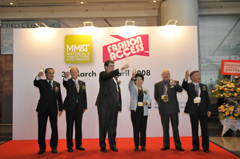The word leather has all but disappeared – this section of the fair is billed as MMT – Materials, Manufacturing and Technology – and Adelmo Borsani of ANCAPLAST gave a seminar entitled ‘Non-woven microfibre matching soon genuine leather.’
This is a reflection on the state of the market. UNIC used to bring 400 tanners to APLF. At this year’s edition there were 80 Italian tanners, synthetics and components companies in the pavilion.
Similarly the Spanish delegation has declined from over 60 companies seven years ago and this edition welcomed 22 companies including footwear components and machinery.
Fair director Michael Duck stated that APLF has recognised that the emphasis today is increasingly on fashion. Duck told a press conference that the secret of [APLF’s] continued success is not just keeping up with market developments – but trying to see ahead of them. He believes that the fair is able to keep ahead of the curve.
However, despite the switch in focus towards fashion, this year the fair lacked a catwalk fashion show. According to Duck this is because national trade delegations from countries such as Türkiye and Spain no longer have the money to fund the designers, models etc, employed in the past. However, there is an opportunity here as APLF would be keen to receive proposals from anyone who wished to put on a fashion show at next year’s event.
The 24th edition of APLF ran from March 31 – April 2 at the Hong Kong Convention and Exhibition Centre (HKCEC). MMT welcomed 1,123 exhibitors from 56 countries and regions. The largest number of exhibiting companies came from China (195), Italy (165), Hong Kong (142), India (74) and Pakistan (59). There were 28 group pavilions and a first time participation from the Egyptian tanners. Halls 1 and 2 hosted hides, skins and finished leathers, process chemicals and dyes, tanning machinery; while as last year, Hall 3 was dedicated to non-leather materials, components and accessories.
Levels of activity did not seem high. Hide traders felt there was little demand for medium to higher quality skins, while machinery and chemicals suppliers confirmed that there were less visitors than in previous years, but stated that the quality/ seriousness of the visitors there were was highly satisfactory.
In a shrewd move, the APLF organisers laid on shuttle buses from Dongguan and Shenzen for producers and technicians.
One of the talking points at the show was the decline of the euro against the Hong Kong dollar over the last year. On the other hand, the strong yen meant an increase in the number of buyers from Japan.
There were very few European chemicals companies exhibiting at APLF with the exception of Schill & Seilacher, Kemia Tau, Carpetex and Heim, but Asian companies were present such as Donyon from China and Vishnuchrome from India. However, in a further indication of the movement of the fair and the market in general, Clariant (while not exhibiting in MMT) hosted a dinner in the Prime Source Forum for 300 people with a Pantone theme so they are clearly targeting more textiles. (Prime Source Forum attracted buyers from Saks, Vanity Fair, Liz Clairborne etc)
The finished goods part of the event, entitled ‘Fashion Access’ hosted 753 exhibiting companies from 39 countries and regions. An ‘eco-luxury sector’ was located in Hall 5 featuring bags, shoes and leathergoods that ‘support earth-friendly and socially relevant values’.
‘Brazilian eco-fashion’ was organised by Brazilian footwear association Assintecal. Participating projects include one which helps rubber tappers in the Amazon access the value addition chain and create the highly fashionable Hawaiana flip-flops which retail in London for upwards of £20 per pair. Assintecal and the Apex export agency launched the network to promote natural and recycled Brazilian products such as cork, banana tree fibre, natural latex and coconut. In addition member companies pledge to use productive processes which are not harmful to the environment.
Throughout the fair, organisers provided seminars covering a wide range of topics. Fashion-focused seminars were particularly popular, and the Peclers Paris ‘Fall-Winter 2009-10 inspirations, Trends with colours and materials influences’ presented by Mary Yan Yan Chan, attracted 300 attendees.
On a more technical note, Yves Morin of CTC Groupe gave a presentation: ‘over 100 years of expertise in footwear, leather and leathergoods’, while BLC hosted a half day programme on ‘Sourcing Leather with Confidence – Responsible Supply Chain management’.
Although the fair was reduced to three days this year and despite strict orders to the contrary from organisers, most stands had been packed up by lunchtime on the last day (Wednesday 2).
Meanwhile, capacity at the venue is being increased. The 20,000 square metre extension to the HKCEC, which cost US$400 million, is scheduled for completion at the end of this year and according to Michael Duck will improve crowd flow.


